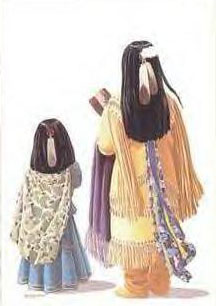|
|
Canku Ota |
|
|
(Many Paths) |
||
|
An Online Newsletter Celebrating Native America |
||
|
December 29, 2001 - Issue 52 |
||
|
|
||
|
Indian Walk-In Center Creating Youth Program |
||
|
by Tom Wharton Salt
Lake Tribune-December 23, 2001
|
||
|
|
|
Offices for health education, primary medical and dental care, substance abuse treatment, diabetes services, counseling, youth programs and a food bank are stacked with papers and decorated with American Indian art. In the board room, a colorful painting by American Indian children at Lincoln Elementary who took an art class from a Hopi teacher dominates the walls. Upstairs, the pervasive silence in a large assembly room belies the many powwows and celebrations that have taken place there. Gay Dawn Pinnecoose, an eastern Shoshone-Arapaho from Wyoming with a love of Indian sports history, physical education and children, has been working with Walter Watchman to create a youth program. Watchman, a Navajo father of six young boys, is earning his degree in chemistry and math from Weber State University. He is the regional representative for college students in Utah, Colorado, New Mexico and Arizona for the American Indian Science and Engineering Society. By combining their talents, Pinnecoose and Watchman are creating a program designed to help American Indian teens ages 13 to 17 who live in the Salt Lake Valley. "We offer classes that help to strengthen youth using a holistic approach," said Watchman. "They cover physical, mental, social and spiritual needs." The program serves more than 100 and, like many others devoted to adolescents, focuses on education to prevent drug, alcohol and tobacco use. "The programs we have let them know to be proud of who they are," said Watchman. "There is a difference between reservation and urban youth. On the reservation, there are Indians all around you. In an urban center such as Salt Lake City, do I see anyone that is an Indian? You are hit with the stereotypes and the youth are confronted with self-identity problems. They are trying to discover who they are." Education programs are designed to explore the strength of Indian cultures, and promote the importance of family and elders in a youth's life. "There are a lot of good traditions in Indian culture that can build self-esteem and self-confidence," said Watchman. "They can be Native Americans in the community and at the same time be successful in the community." Pinnecoose said the youth group searches
for community service projects. She said the young people learn shawl
making, dancing, bead work, traditional music, flute making and drum
making. Watchman and Pinnecoose said their primary need is for an electrician to donate work on outlets in the youth room so computers can be hooked up. The center also needs books and shelves for a library, incentives in the way of athletic tickets or movie passes for youths who complete programs, all kinds of sports equipment, disks for computer classes, a television with a VCR, a camcorder to preserve historical events and a white board with markers. "In all of our programs, the money we get from the Indian Health Service is limited," said Indian Walk-in Center director Gail Russell. "We always look at local resources to enhance these resources and youth are a big need." Other needs include warm men's coats and food to restock a United Way-supported food bank that is available not only to American Indians but to anyone who lives in the community. The Indian Walk-In Center is located at 120 W. 1300 South. A youth benefit powwow is planned Jan. 12 at 6 p.m. that will include raffles, exhibitions and food. For more information, contact the center at 486-4877. |
|
|
||
|
|
||
| Canku Ota is a free Newsletter celebrating Native America, its traditions and accomplishments . We do not provide subscriber or visitor names to anyone. Some articles presented in Canku Ota may contain copyright material. We have received appropriate permissions for republishing any articles. Material appearing here is distributed without profit or monetary gain to those who have expressed an interest. This is in accordance with Title 17 U.S.C. section 107. | ||
|
Canku Ota is a copyright © 2000, 2001, 2002 of Vicki Lockard and Paul Barry. |
||
|
|
|
|
|
The "Canku Ota - A Newsletter Celebrating Native America" web site and its design is the |
||
|
Copyright © 1999, 2000, 2001, 2002 of Paul C. Barry. |
||
|
All Rights Reserved. |
||

 The
Indian Walk-In Center in the old Carpenters' Union Hall near Franklin
Covey Field has the feel of a well-used community service center.
The
Indian Walk-In Center in the old Carpenters' Union Hall near Franklin
Covey Field has the feel of a well-used community service center.